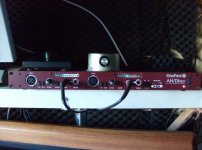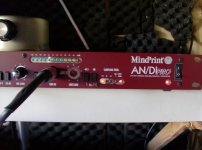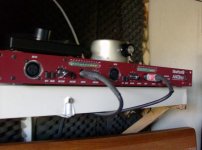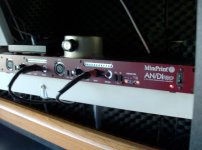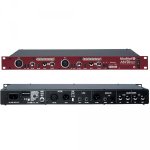glowingfish
Ouwe rot
Mindprint AN/DI Analog to Digital converter with preamp and powersupply and input potmeter upgrade !
Underrated A/D converter with very neutral and musical sound. This one is modified and upgraded with better BurrBrown OPA2134 opamps and Panasonic capacitors in the pre-amp circuit and power supply circuit. Since you can never get the same input balance with 2 seperate cheap mono potmeters, this one has a stereo ALPS blue potmeter for accurate and precise stereo balance of the input level.
This mindprint can measure with Apogee, Benchmark and RME.
Thank you for watching and if you want more (better) photo's or have any questions, please let me know !
299E
Specs:
AnDi Pro
Today, modern hard-disk recording systems housed in supercharged computers deliver the kind of impressive performance and track capacity that can measure up to the finest studios. With word lengths of 24 or 32 bits, the audio quality of the systems is impeccable.
Nonetheless, the high quality of today’s processing options can't be exploited to full effect when used with standard sound cards, because the A/D converters in these cards easily distort, and because interference generated from the clock frequencies inside the computer housing degrades the signal-to-noise ratio.
The remedy is to use a high-quality converter housed in an external device so that the signal can be patched into the computer without loss or hassle.
In addition, AN/DI PRO is equipped with a Word Clock input of the type used for professional audio and broadcasting applications.
Underrated A/D converter with very neutral and musical sound. This one is modified and upgraded with better BurrBrown OPA2134 opamps and Panasonic capacitors in the pre-amp circuit and power supply circuit. Since you can never get the same input balance with 2 seperate cheap mono potmeters, this one has a stereo ALPS blue potmeter for accurate and precise stereo balance of the input level.
This mindprint can measure with Apogee, Benchmark and RME.
Thank you for watching and if you want more (better) photo's or have any questions, please let me know !
299E
Specs:
AnDi Pro
Today, modern hard-disk recording systems housed in supercharged computers deliver the kind of impressive performance and track capacity that can measure up to the finest studios. With word lengths of 24 or 32 bits, the audio quality of the systems is impeccable.
Nonetheless, the high quality of today’s processing options can't be exploited to full effect when used with standard sound cards, because the A/D converters in these cards easily distort, and because interference generated from the clock frequencies inside the computer housing degrades the signal-to-noise ratio.
The remedy is to use a high-quality converter housed in an external device so that the signal can be patched into the computer without loss or hassle.
- Master converter in an analog studio To convert stereo master signals in an analog studio into digital, the line input of the AN/DI PRO can be connected directly to the mixing console's output, thereby preserving the sound quality of the analog signals as well as their impressive dynamic range. From the AN/DI PRO’s digital outputs, the signal would then be routed to a master recorder or to the digital I/0 card of a computer.
- Input converter in a digital studio In digital signal processing, conversion is executed at the very beginning of the digital signal chain. The line output of an instrument, or a microphone, is connected directly to the appropriate input of the AN/DI PRO, at which point it is immediately digitized to retain the integrity of the original signal.
- Live recording Another interesting way of putting the AN/DI PRO to work is as a digital front end for recording live. This unit in combination with a classic two-microphone setup and a 24-bit DAT recorder or computer/laptop makes for a top-notch mobile recording system. With the benefit of the high-quality microphone preamplifier and—immediately thereafter in the signal chain—post-preamp 24-bit conversion, this setup delivers the best possible signal-to-noise ratio, and leaves plenty of reserves for post-processing in the studio. Particularly in the field of classical music, many systems are quick to exceed their limitations. AN/DI PRO makes the decisive difference here.
- What are 24 bits good for? When recording with a 16-bit converter, often only 14 bits are actually used to represent the signal. The other two bits are reserved as a kind of digital headroom. During processing, quantization noise—initially soft—becomes more perceptible. Digital post-processing generates rounding errors that are always apparent in the lowest bit.
For these reasons, it's a good idea to work with 24 bits and convert the signal down to the 16-bit CD format as the final step in the processing chain. The great advantage here is that the potential of the CD format is exploited fully, right down to the last bit. Tracks thus end up with the best possible dynamics, definition and fidelity. - What are 96 kHz good for? Shannon's sampling theorem states that the highest frequency contained in the audio signal may be equal to no more than half of the sampling rate. Therefore, a maximum of 22.05 kHz can be represented by the CD standard of 44.1 kHz.
With a sampling rate of 96 kHz, the audio spectrum can comprise frequencies up to 48 kHz. Peripheral noise introduced by audio clean-up operations can be shifted well out of the range of human hearing. Digital post-processing operations end up sounding much cleaner and more neutral. - Input section The AN/DI PRO is equipped with a complete input section comprising a studio level line input, a microphone input with a 20-dB damping switch, and switchable phantom power for condenser microphones. The input section actually consists of two separate circuits, enabling the two channels in the stereo pair to be processed independently. With the benefit of these dual circuits, the AN/DI PRO can be used for stereo signals as well as for two separate monaural channels.
- Level Meter In contrast to analog gear, digital devices aren't designed to accommodate saturated signals. To prevent overloading, the AN/DI PRO is equipped with a large 12-segment LED ladder.
It is essential that you leave enough headroom to prevent the signal from crossing the clip threshold. However, at the same time, this headroom should be kept as tight as possible in order to hold quantization noise to a minimum. - AN/DI PRO's 24-bit technology and superior dynamic range of up to 116 dB make it much easier to meet these requirements because the ratio of the clip threshold to quantization noise is considerably greater than is the case with conventional converters.
- A/D Converter After the premium preamp section has worked its audio magic, the signal is converted so that it can be introduced into the digital domain. The converted signal is routed out simultaneously via AES/EBU, S/P-DIF coaxial and S/P-DIF optical interfaces. The word length of the digital signal is 24 bits. The device fully exploits the technical potential of the AED/EBU and S/PDIF standard right down to the last bit. In terms of sampling frequency, the device features the standard 44.1 and 48 kHz settings, plus the state-of-the-art 96-kHz format, which is well on its way to becoming the standard for professional recording.
- Inserts Often during the recording process you may deliberately want to color or process an audio signal using analog gear. So that you can insert analog devices such as equalizers, compressors or tube amps into the signal chain, the AN/DI PRO is equipped with Send and Return jacks. The input(s) of the external device should be connected to the Send jack(s) of the AN/DI PRO, and the processed output signal of the external device should be routed to the Return jack(s). This means analog processors become component parts of the signal chain, the final stage of which is digital conversion in outstanding quality.
In addition, the Send jacks can be used as an analog post-mic preamp output, and the Return jacks provide direct access to the converters. - Synchronization Whenever several digital audio devices are connected to one another, their internal clock frequencies have to be synced up. To this end, AN/DI PRO is equipped with a truly a unique feature, the AES/EBU and S/P-DIF Sync ports. The requisite clock frequency information is included in every AES/EBU and S/PDIF signal. This means that if the AN/DI PRO is connected to any unoccupied digital output of a synchronized device, it will automatically adapt its internal clock to match the frequency of the other device!
In addition, AN/DI PRO is equipped with a Word Clock input of the type used for professional audio and broadcasting applications.
